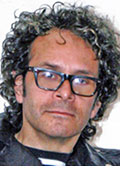Design, engineering students create new Bright installation

Frank Malina

Gabriel Esquivel
“Pop/Op,” a new piece of [kinetic art] (http://en.wikipedia.org/wiki/Kinetic_art) inspired by [Pop Art] (http://arthistory.about.com/od/modernarthistory/a/Pop-Art-Art-History-101-Basics.htm) and pop-up books, the result of a collaboration between design and aerospace engineering students at Texas A&M, is a new adornment to the Bright engineering buildling’s south entrance.
Elements of the piece, designed by students in a digital fabrication class led by Gabriel Esquivel, assistant professor of architecture, will be in constant motion powered by hardware and software programmed by Dan Whitten, a mechanical engineering major and an undergraduate research assistant with the Texas Institute for Intelligent Materials and Structures, a Department of Aerospace Engineering affiliate.
Whitten used [Arduino] (http://www.arduino.cc/) , an open-source electronics prototyping platform, to create movement in 30 elements in the piece, creating a sense of motion from left to right. The electronic signals to the elements from an Arduino control box pass through [shape memory alloy] (http://en.wikipedia.org/wiki/Shape-memory_alloy) wire, donated by [Dynalloy, Inc.] (http://www.dynalloy.com) and [SAES Getters] (http://www.saesgetters.com) , which responds to an electrical current by shrinking or expanding.
Stephen Cornell, a graduate aerospace engineering student, fabricated some of the wire components in the TiiMS materials and structures lab.
Esquivel said his students began their design by researching the aesthetics of motion, which led to their emphasis on Pop Art and pop-up books in the piece.
“’Pop/Op’ creates motion through overlapping layers, graphics and the moving elements,” said Esquivel.
The students made extensive use of the College of Architecture’s [Digital Fabrication Facility] (http://www.arch.tamu.edu/inside/services/digital-fabrication/) at Texas A&M’s Riverside Campus to create the piece.
They created a composite made from a fiber-reinforced material called c-glass, coated it with an epoxy resin and fabricated the piece’s layers and elements on the CNC router.
They created a script using [Grasshopper] (http://www.grasshopper3d.com/) software to fabricate the piece’s images and panels.
The piece wasn’t a preconceived idea at all,” said Esquivel. “The design emerged from our research discoveries.”
Darren Hartl, an assistant research professor with the Department of Aerospace Engineering, was enthusiastic about the collaboration.
“In teaming with the design students, we were provided with a design challenge in which aesthetic goals can, at times, supersede quantified and purely functional objectives,” said Hartl, “This is an opportunity to carry our technological solutions to a new and broader audience.”
In the spring 2013 semester, Esquivel said his students will again collaborate with aerospace engineering students to create another, more complex kinetic piece.
“The collaboration is an indication of where architecture can go in combination with other disciplines,” said Esquivel. “This is taking architecture into a new territory that includes animation and robotics.”
Esquivel’s students began working with their counterparts in aerospace engineering during the spring 2012 semester, when they worked with Hartl to [evaluate] (http://one.arch.tamu.edu/news/2012/4/27/exploring-forms-materials/) the structural integrity of composite materials they used to create unconventional home exteriors.
Esquivel said “Pop/Op” is also a tribute to engineer/artist [Frank Malina] (http://www.fondation-langlois.org/html/e/page.php?NumPage=233) ’34, who earned master’s degrees in aeronautical and mechanical engineering at Texas A&M.
Malina, who co-founded the [Jet Propulsion Laboratory] (http://www.jpl.nasa.gov/) , was its director from 1944-46. He was also a kinetic artist who became internationally recognized as a pioneer of light and motion in art. He also founded [Leonardo] (http://www.leonardo.info/leoinfo.html) , a research journal focusing on the interactions between contemporary arts, science and technology.
Malina conceived and directed the design, construction and testing of the United States' first successful high-altitude research rocket in 1945, and his kinetic art is in collections including the Smithsonian Institution and art museums in Paris and San Francisco.
Tags
- academics
- arch gallery
- architecture
- archone gallery
- art
- coa gallery
- fabrication
- interdisciplinary
- partnerships
- rss
- studio projects
- technology
- undergraduate work
- video
Related Posts

Innovative ‘green’ wall features sheet metal, native plants

Students create new designs for children’s treatment center

Texas A&M researchers enabling buildings to ‘breathe’

Student-designed, built ‘tiny’ homes to house homeless

Treatment center designs aid PTSD, head-injured vets
Follow Us
Facebook Twitter Vimeo Youtube Flickr RSS
Recent Posts

Planning prof heads study of disaster housing aid

A message from the dean

Former student remembered as expert planner

Leading educator named new head of Architecture Dept.









_thumbnail_small.png)
